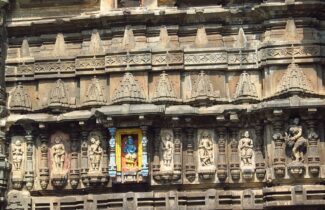Exploring the Divine Beauty of Mahalakshmi Temple in Mumbai
Mumbai, often referred to as the City of Dreams, is a bustling metropolis that never sleeps. Amidst the chaos of the city, there exists a tranquil oasis of spirituality known as the Mahalakshmi Temple. Nestled in the heart of Mumbai, this temple is a revered place of worship that draws devotees from far and wide, due to its popularity, it is a stop that many make on an India tour.
The Mahalakshmi Temple, dedicated to Goddess Mahalakshmi, is one of the oldest and most significant temples in Mumbai. It dates back to the 18th century when it was constructed by Dhakji Dadaji, a Hindu merchant. The fact that this temple is steeped in history, is one of the reasons it stands out in a tour of Mumbai. The temple has undergone several renovations and reconstructions over the years, but it continues to stand as a symbol of devotion and faith. Although it is a functioning religious temple, many non-Hindus visit as part of an India tour.
The Mahalakshmi Temple is unique in that it houses not one, but three idols of the divine feminine. The central deity is Goddess Mahalakshmi, the goddess of wealth and prosperity. She is depicted with four arms, holding a mace, a chakra (discus), a lotus, and a conch shell, symbolizing her godly attributes. To her right is Goddess Mahakali, the fierce and powerful form of the goddess, while to her left is Goddess Mahasaraswati, the embodiment of knowledge. This trio represents the three essential aspects of feminine energy – creation, preservation, and destruction.
The Mahalakshmi Temple’s architecture is a blend of classical and contemporary styles. The temple’s entrance is adorned with intricate carvings and decorations that reflect the rich heritage of Indian temple architecture. The temple’s inner sanctum is a serene and spiritually charged space where devotees can offer their prayers and seek the blessings of the goddesses. The soothing ambiance and divine energy within the temple provide a respite from the hustle and bustle of Mumbai.
The Mahalakshmi Temple comes alive during festivals, especially during Navratri, which is dedicated to the goddess. Navratri is a nine-night festival celebrated with great fervour and devotion. The temple is adorned with colourful decorations, and special pujas (prayer ceremonies) are conducted. Devotees come to the temple during this time to witness the divine fervour and seek the goddess’s blessings.
While this particular temple is extremely busy during specific festivals, it is also one of the most entertaining times to visit as part of your tour of India. While some people may avoid the temple during this period due to the crowds, it is one of the best times to visit.
Apart from being a place of worship, the Mahalakshmi Temple is also known for its charitable initiatives. The temple trust actively engages in various social and philanthropic activities, including educational and healthcare services for the underprivileged. This commitment to serving society exemplifies the temple’s values of compassion and generosity.
If you plan to visit the Mahalakshmi Temple, here are some practical tips:
Dress modestly: Like all Indian temples, it’s advisable to dress modestly, covering your shoulders and knees.
Respect traditions: Follow the temple customs and traditions, such as removing your shoes before entering the temple premises.
Avoid rush hours: To experience the temple’s serenity, visit during non-peak hours to avoid large crowds.
Offerings: You can make offerings of flowers, coconuts, and other items to seek the goddess’s blessings.
The Mahalakshmi Temple in Mumbai is not just a religious site but a symbol of cultural heritage. It serves as a reminder of the timeless connection between the divine and the human, amidst the fast-paced urban life of Mumbai. Whether you are a devout believer or an admirer of art and architecture, a visit to this sacred temple is an enriching experience that allows you to connect with the deeper spiritual roots of India’s diverse culture and it is a great stop on any India tour.


